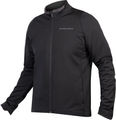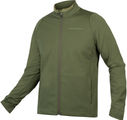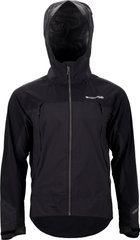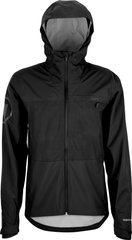Jackets & Vests
OUR Jackets & Vests RECOMMANDATIONS
Our Suggestions
Jackets, like cycling vests, offer four main functions:
- Weather Protection: Worn as an outer layer according to the so-called "onion principle", weather protection jackets protect you from the weather, e.g. rain, wind and snow.
- Insulation: Thermal jackets and vests provide warmth. More precisely, they insulate your body heat. There are two main versions: There are jackets – less often vests – that are worn as an outer layer, such as a lined rain or wind jacket, for example. And then there are garments that are worn as mid-layers underneath weather protection when needed. For cycling, the first version dominates, while in other outdoor sports disciplines the so-called layering principle is often preferred.
- Safety: Being seen is always important. Not only on the road bike or while commuting. Bright, eye-catching colours help here just as much as reflective elements. This is why many cycling jackets or vests are reflective, either completely or partially; our "High Visibility" filter can help you find the right one.
- Style: Bike jackets and vests often serve as a fashion statement. Hardly any other garment is so visible and exposed. Here you will find jackets and vests in numerous styles and from many established brands, including Endura, Giro, Specialized, Assos, Fox Head, Gore Wear, Loose Riders, Patagonia, 7mesh, POC or VAUDE.
Bike jacket or vest?
Vests are jackets without sleeves but by no means deliver half the performance. They offer an advantage especially when breathability and freedom of movement are particularly important, such as on short, intensive laps or in competitions. You can view all vests at-a-glance by clicking on the corresponding filter.
It’s best to wear a jacket whenever you are looking for uncompromising weather protection or maximum warmth, e.g. on long bikepacking or gravel adventures, in the mountains, in bad weather regions or in winter – or if you simply prefer a certain level of comfort.
The optimal weather protection: Rain jackets and wind jackets for cycling
When it comes to weather protection (and in our shop), you have the choice between rain and wind jackets or vests.
- Rain Jackets: Waterproof jackets are automatically windproof and therefore very versatile, and the right choice for bad or changing weather conditions. Rain jackets therefore not only keep you dry, but also protect you from chill, for example on descents. A jacket is made waterproof either with a coating or a high-quality membrane such as the one made famous by Gore-Tex, which is protected inside the jacket. Gore Wear only uses membranes from its sister brand, W. L. Gore & Associates, such as Gore-Tex Shakedry. Other manufacturers use different but comparable technologies, such as the recycled and recyclable Sympatex membrane used in VAUDE products or MT500 and similar by Endura. In addition, waterproof jackets have a DWR coating ("Durable Water Repellent"), which prevents the outer material from becoming soaked. Rain jackets are also often called "hardshell jackets".
- Wind Jackets: There are windproof and wind-repellent jackets and vests. Both categories are water-repellent, but not completely waterproof and have the well-known DWR finish. If breathability (actually "vapour permeability") is particularly important to you, for example in competition, give wind-repellent designs (also called windbreakers) a chance. They are also usually more breathable. Windproof products offer more weather protection. Bike wind jackets and wind vests are often ultra-light, can be packed small and also fit into a jersey pocket or small saddle bags. A speciality in the field of wind jackets are softshell cycling jackets (and vests). Their soft outer material is often stretchy, very comfortable and quiet, but not quite as lightweight as classic windbreakers.
Keeps you warm: The thermal jacket for your bike
Thermal or insulating jackets and vests for cycling have a clear purpose: to keep you warm. That's why they are particularly suitable as winter jackets for MTBs, gravel bikes and so on. Thermal clothing can be waterproof and windproof to function as an outer weather protection layer, but it doesn't have to be. It's just as possible, for example, to carry an ultra-light down or synthetic fibre insulation vest in your luggage, which you simply wear under your rain jacket when needed.
Synthetic fibres such as well-known fleece or modern hollow fibres such as Primaloft can be used as well as natural fibres such as wool and down.
Important: Size, cut and fit
Of course, your bike jacket should fit you! But what does that mean exactly? That depends on how and when you wear it. The more active you are, the tighter the cut can be. This makes it easier to use a mid-layer and prevents your weather protection jacket from flapping around annoyingly. However, make sure that the jacket or vest is not so tight that it restricts your freedom of movement.
A special case is insulation using the onion principle: Here it is not the fibre that warms, but mainly the air between the fibres and layers of clothing. If you go for a flexible combination of warm underwear, insulating mid-layer and rain jacket, make sure the insulation layers don't get flattened.
Outerwear for cyclists is usually cut slightly longer at the back. This way your new cycling jacket (or vest) also covers the lower back as well as the area towards your backside. This is crucial if you adopt an especially athletic position on your road bike, gravel bike or mountain bike.
For the same reason, bike jackets often have slightly longer sleeves or sleeve tops. So cycling gloves and jacket sleeves are flush and don't give rain a chance.
Special case: The "Dirtsuit”
Are you a mountain biker? Then you definitely know about dirtsuits and the like, as offered by pioneer dirtlej, among other manufacturers. Rain jackets and pants are merged here into one protective garment, available with short or long arms and legs. This will keep even the worst dirt out.
Which cycling jacket is good for winter?
Here you have the choice of either a single waterproof and lined jacket or a combination of a warm mid-layer and waterproof hardshell jacket. The first version scores with its easy handling, while the second offers more in terms of flexibility.
Cycling jackets for men and women
Like most garments, bike vests and cycling jackets are also available in women's and men's versions, as well as some unisex versions. They differ in cut and partly in colour. However, the basic requirements for material and technology are identical.
Breathability & Durability
Breathability or vapour permeability is based on a simple principle. Your excess body heat can escape to the outside in the form of warm, moist air through the material, while keeping out raindrops and wind. For this to work, however, you should bear two things in mind:
- The total breathability is only as high as the breathability of the least vapour-permeable layer. If you're wearing simple cotton underwear that soaks up sweat in an instant, dries slowly and therefore doesn't allow your perspiration to pass through the soaking wet fabric, even the best Gore-Tex jacket won't do you any good. You will stew in your own juices!
- Regularly reapply a fresh layer of your garment’s DWR coating with an appropriate textile waterproofer (do not use shoe waterproofer!). When water no longer beads up on the outside, but soaks into the outer material like a sponge, it's high time for a refresh. The same principle as before applies in this case: if the outer material is full of water, it no longer allows perspiration to pass through.
By the way: Functional textiles need to be washed regularly. Sweat, sebum or cosmetics can otherwise damage laminations, seam tape seals or jersey fabrics. Make sure to wash your rain, wind and thermal jackets for biking regularly with a special detergent for functional clothing. Follow the manufacturer's care instructions on each garment’s label.
Advice
Tips and Tricks






























































